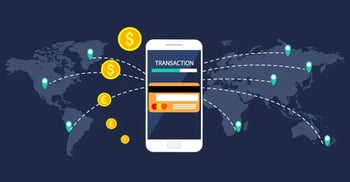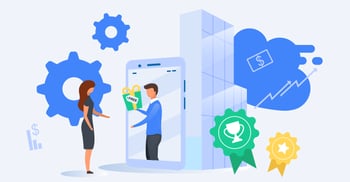How to Price Digital Downloads: From Free to Premium Guide
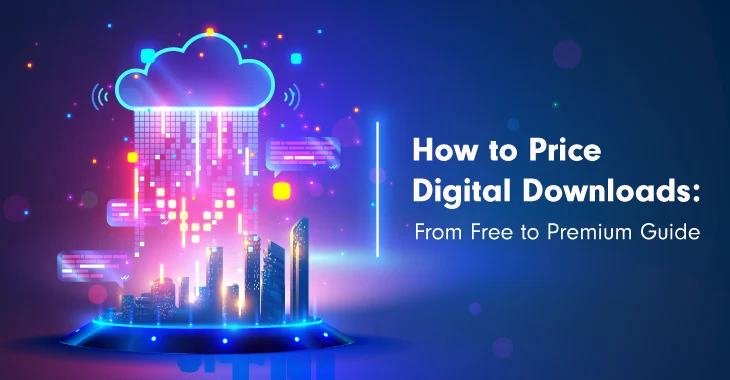
For businesses seeking to monetize digital downloads, pricing these products can be an arduous process.
This is due to the fact that finding the ideal price point that balances revenue maximization and the satisfaction of customer demands requires a meticulous approach.
Let’s discuss the various pricing strategies and best practices for businesses when marketing digital downloads.
What are Digital Downloads?
They are digital files that can be purchased and stored on a device such as a computer, smartphone, or tablet. This material includes a wide range of things, including but not limited to music, online courses, video games, TV shows, movies, e-books, software, and other digital media.
Upon purchasing a digital product, a download link or access code is typically provided to enable the user to access and download the material onto their device.
Compared to physical media, such as CDs or DVDs, digital downloads are considerably more convenient, portable, and space-saving. Moreover, it is often obtained and downloaded without delay, sparing the user from the hassles of shipping or waiting for the physical medium to arrive via mail.
5 Reasons Why Correctly Pricing Digital Downloads Matters
The primary goal of setting the right price for digital downloads is to generate sales. However, there are many other important considerations as well.
Strategically pricing digital downloads conveys the idea that the content shared by an online business is valuable. While the freemium approach is widely accepted among developers selling digital downloads, it should be regarded as one step in a greater, more complex strategy.
Additionally, by establishing appropriate pricing, content producers or distributors gain more control over how their work is distributed and can restrict access to paying clients.
The cost of digital downloads may affect brand reputation. A lower price could be an indication of poor quality or desperate marketing. On the other hand, a higher price may discourage potential clients and result in unfavorable evaluations.
Setting a fair price for digital downloads is absolutely necessary for preserving a strong brand reputation.
In conclusion, pricing digital downloads is essential for businesses that sell digital products as far as earning income, fostering a sense of value, controlling distribution, and upholding a brand's good reputation are concerned.
The MECE Framework for Pricing Digital Downloads
The MECE (Mutually Exclusive, Collectively Exhaustive) framework is a structured problem-solving approach used in various industries and disciplines, including consulting, business, and engineering.
The framework requires breaking down a complex problem into mutually exclusive and collectively exhaustive categories or groups. These categories must also be collectively exhaustive, meaning that they must cover all possible options without any gaps or overlaps.

The MECE framework has broad applicability in numerous areas, such as pricing strategy, market research, product development, and project management.
Its value lies in ensuring that all possibilities are considered and that redundant or irrelevant options are eliminated, resulting in better decision-making. Here are the 4 steps involved in the process:
Step 1: Identify the target audience
Looking at Demographics
By breaking up the overall population into smaller, more focused subgroups that have comparable traits or requirements, the MECE framework can be utilized to pinpoint the target audience.
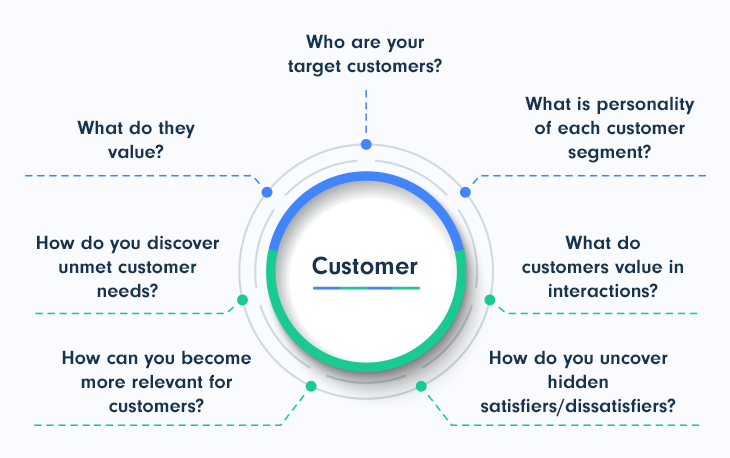
To better personalize your content or product to satisfy their demands, it is crucial to study these subgroups' distinct needs, interests, and behaviors once they have been identified. You can then ensure that you are speaking to the appropriate people and sending the correct message.
Creating Strong Value Propositions
First, determine the many benefits that you are providing for your customers to develop a compelling value proposition for your good or service. For instance, your product may boost their productivity, enhance their health, or save them time.
The next stage is to divide these advantages into separate, mutually exclusive categories. Thus, each benefit should go under just one category. You might divide your advantages into groups like "time-saving benefits," "health benefits," and "productivity benefits," for example.
By structuring the value proposition in this way, you may make it easier for clients to comprehend why they should select your product over competing options by clearly articulating the main advantages that your service provides.
Step 2: Analyze your competition
Identify the key competitors in the market
To evaluate a market or industry, identify the top competitors, direct and indirect. After identifying them, classify your competitors by traits such as size, location, product offers, customer base, and price strategy.
Each contender should fit into one category. Remember, the categories must be mutually exclusive. This helps organize the competitive landscape and generate effective business strategies.
Evaluate each category
Once you have divided your competition into different categories, it's important to thoroughly assess each one. Dive deep and uncover the strengths and weaknesses of the competitors, understand the key components for success within those fields, then compare how your own business measures up against their level of achievement.
Step 3: Determine the value of the product
Identify the features of the product
Discover the unique components of your product by identifying its many features - from function and design to durability or ease of use. Then, group these attributes into distinct categories based on their value. For instance, you could separate must-have characteristics from extra bonuses compared to similar products. Additionally, defining which market segment each feature is best suited for will help optimize success within a targeted consumer base.
Create unique key selling points
Leverage the data gathered from each product/service category to craft an unforgettable customer experience. Pinpoint features and advantages that will set your product or service apart from rivals, making it truly stand out in its field.
Step 4: Consider the pricing strategy
Evaluate different pricing strategies
Deciding on your pricing model is the first step in creating a monetization plan for your business. Cost-plus pricing, value-based pricing, penetration pricing, and skimming pricing are a few examples of these.
The next step is to group the prospective pricing methods based on their traits or properties after you have discovered them.
This classification may be based on the target market, the degree of competition, the special qualities or advantages of the product, or the degree of price sensitivity among consumers.
Analyze each category
After carefully classifying the various pricing schemes, it's time to dig in and do a comprehensive evaluation. Consider their strengths and weaknesses for each category, along with major success factors that can ensure your organization achieves its goals while remaining true to its core values.
With this knowledge on hand, you'll be better equipped to create custom-tailored pricing plans made just for your business – ones that align with your objectives yet still provide an effective solution.
Step 5: Implement the pricing strategy
Test the pricing strategy
After choosing a pricing strategy, put it into practice by determining the real prices for your goods or services. This may entail figuring out the ideal price point, examining the effects of various pricing tiers or bundles, and determining the effects of sales or discounts.
Monitor and adjust the pricing strategy
It is crucial to evaluate the success of your strategy and make any necessary revisions. This could entail keeping track of sales and earnings as well as getting customer input on how they feel about prices.
Pricing Digital Downloads: 5 Factors To Consider
Digital download prices should be based on several things. This includes the seller and customer psychology, market demand, rival price, manufacturing and delivery costs, perceived value, and pricing elasticity.
1. Production and Delivery Expenses
Digital download production and distribution costs include gear, software, hosting, payment processing, and development.
2. Valuation
Digital downloads' usefulness, innovation, and personalization demonstrate value. Pricing should reflect the content's worth to the client.
3. Pricing Psychology
Digital download revenue depends on pricing psychology. Price psychology principles include:
A cheaper item may look more inexpensive and valuable when compared to a more costly one.
Customers may find a $9.99 pricing more appealing than a $10 price.
Discounted digital products may make customers feel appreciated and inspired to buy.
Create urgency or scarcity to sell digital goods (e.g., "limited-time offer" or "only X copies left").
Providing numerous software tiers may allow customers to personalize their digital products, making them feel valued and compelled to spend more.
Offering a free trial or sample of a digital product may encourage potential customers to buy.
4. Demand
Target demography, relevance to current events, and marketing methods affect market demand.
5. Price Flexibility
Price elasticity measures how a price change impacts customer demand. Businesses can use several methods to determine pricing elasticity:
Experimentation
Businesses can learn about digital product pricing elasticity by testing multiple price points and tracking sales and income. This may require A/B testing, progressive price modifications, or price comparisons among marketplaces or clientele segments.
Surveys and customer feedback
Businesses can assess how pricing changes affect demand by collecting data on consumer perceptions of value and willingness to pay for a digital product. Surveys, focus groups, consumer evaluations, and testimonials can help.
Data analysis
Sales and revenue data might reveal demand and pricing elasticity patterns. This may involve applying statistical models to analyze how pricing adjustments affect sales or data analytics to detect customer behavior patterns.
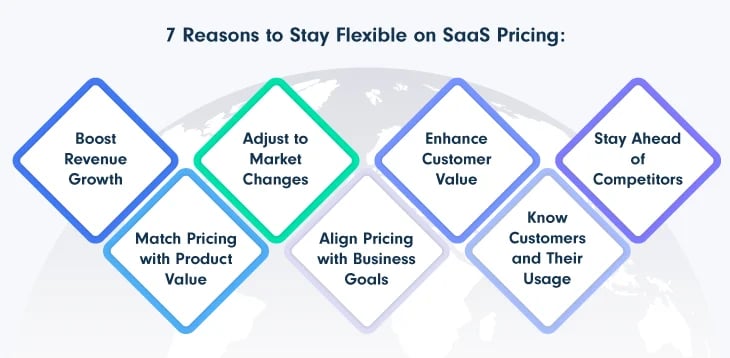
Common Pricing Strategies for Digital Downloads
Pricing your SaaS is no walk in the park. Identifying that sweet spot between development costs, profit expectations, and market demand takes time and effort. But it is, without a doubt, rewarding. There are a variety of pricing strategies that businesses can use to monetize digital downloads. Here are some of the most common pricing strategies:
Time-limited pricing
Time-limited pricing can be a great way to incentivize customers to act fast and take advantage of attractive offers. This strategy includes flash sales, limited-time discounts, and countdown timers that instill urgency by showing the remaining time on promotions or discounts.
While this approach may increase profit in the short term, it is important for businesses to use these tactics wisely since frequent price changes could have negative repercussions in the long run.
Tiered Pricing
Tiered pricing is a method of setting prices that involves delivering various versions of a good or service at various price points, each with more features or capabilities. This enables companies to appeal to various market segments with differing requirements and budgets. It can also give customers ready to pay extra for more features a sense of exclusivity and value.
By upselling clients on more expensive versions of a good or service, tiered pricing can be a successful approach to boost sales volume. It also gives existing customers ready to pay more for extra features a sense of value and exclusivity.
Businesses can utilize tiered pricing to successfully monetize digital downloads and boost revenue by carefully examining the demands and preferences of the target audience and creating a clear and well-communicated pricing strategy.
Pay-What-You-Want
PWYW (pay what you want) is a pricing method that lets customers pay whatever they want for a good or service, frequently with a recommended minimum price.
With digital downloads and products, such as a software program or e-book, typically buyers will choose how much they are willing to pay. Customers pay what they think the product is worth or can afford, giving them a sense of flexibility and value.
Be aware that pay-what-you-want pricing does come with significant dangers. The most obvious being that customers could underpay for the goods or that some will not pay anything at all.
Businesses might consider establishing a proposed minimum price to help reduce these risks. They could also offer additional benefits to consumers who spend more, such as a bonus or more features as an incentive.
By encouraging buyers to spend more than the minimal price, you are fostering a sense of value and exclusivity.
Freemium
Freemium's main objective is to attract a sizable user base by providing a free product. The goal is to monetize that user base by persuading them to pay for access to the extra features or capabilities.
A software product or mobile application may be offered as a free trial or limited version in the context of digital downloads, with more sophisticated features or content only accessible for a price.
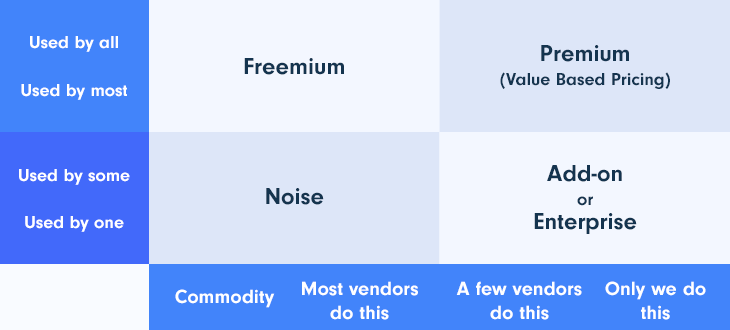
Since consumers are more willing to sample a product or service if there is no fee upfront, freemium can be an effective strategy for growing your user base and winning loyal customers. In addition, it can help businesses generate income from a customer base that might not have been prepared to pay upfront for the product. Customers who are willing to pay for the additional features or capabilities may appreciate these extra options and find added value in your product.
Bundling
The purpose of bundling is to provide clients with a sense of value by giving several products at a discounted rate compared to what they would cost alone.
Offering a collection of software programs, e-books, or other digital products as a package deal at a reduced cost as opposed to buying each one separately is known as bundling in the context of digital downloads.
Because it gives customers a sense of value and can encourage them to buy more, bundling can be an effective strategy to boost sales and revenue.
Bundling does come with certain risks, however. For instance, there's a chance that not all clients will be interested in the combined things, or that the discounted price would make the individual items seem less valuable.
Businesses may need to carefully analyze the goods that are part of the bundle, the cost of the individual items, and the overall product quality and value offered to customers to manage these risks.
Best Practices for Pricing Digital Downloads
Since it requires combining the needs of the business with the tastes and behaviors of the target audience, pricing digital downloads can be difficult. But, when done correctly, it can be extremely rewarding. Be sure to check out our SaaS pricing eBook to really master this art. And in the meantime, here are some price guidelines for digital downloads that will help firms optimize profits while also satisfying client demand.
Use a basic price structure
Using some of the most straightforward pricing options is one of the best ways to set the price of digital downloads.
This means offering a reasonable price for the good or service that is obvious and uncomplicated, without any additional costs or confusing tiers. When selling digital products, going for a complex price structure can frustrate customers and decrease sales or even turn them away altogether.
Provide a free sample or trial
Giving customers a free trial or sample of a digital product can give them a taste of what is offered and increase their likelihood of purchasing. This is particularly useful for software programs and other digital goods that can be challenging to assess without being used first.
Businesses can increase customer trust and credibility and foster a sense of value for the product by providing a free trial or sample. Not to mention that this practice could pave the way toward setting premium prices.
Make use of social proof
Being capable of boosting customer confidence and trustworthiness, social proof can be a powerful strategy for pricing digital downloads.
This can involve leveraging customer endorsements, ratings or reviews to highlight the benefits of the good or service and to convince new customers that other people have had good experiences using it.
Think about localization
Among other pricing strategies that have proven highly effective in increasing sales, is pricing localization which is definitely worth testing. By localization, we mean: adjusting to fit particular markets or geographic areas, taking into consideration things like currency conversion rates, regional taxes, and cultural differences.
Offering prices in different currencies, modifying prices to reflect local taxes and levies, or accounting for cultural variations in pricing expectations can all be part of this.
Testing and adjusting prices frequently
Last but not least, it's extremely important for businesses to continually evaluate and modify prices based on feedback and behavior from customers. This means running A/B tests to compare the effects of various pricing methods, altering prices in response to changes in the market or customer research, or testing out various pricing structures to determine which is most effective. Businesses can improve their pricing strategy over time and increase revenue by routinely evaluating and modifying pricing.
Carefully considering and arranging the pricing of digital downloads is necessary, taking into account elements like the state of the market, consumer preferences, and the level of competition.
Thrive with the industry’s most innovative all-in-one SaaS & Digital Goods solution. From high-performing payment and analytics tools to complete tax management, as well as subscription & billing handling, PayPro Global is ready to scale your SaaS.
Sell your SaaS globally with PayPro Global!
How Can PayPro Global Help?
PayPro Global is an all-in-one eCommerce solution, enabling digital download developers to leverage the power of technology for selling and distributing their unique online products. Here are some of the tools we equip businesses with:
Various pricing alternatives: PayPro Global offers a comprehensive suite of pricing strategies for businesses to select from, ensuring an ideal solution fits their audience and business objectives. With options ranging from flat rate schemes, subscription models, pay-as-you-go plans, or tiered approaches - companies have every opportunity to find their perfect strategy.
Localization: PayPro Global's localization capabilities provide businesses with the unprecedented ability to craft localized pricing and payment experiences. By giving customers the value they're looking for, it makes international markets more accessible than ever before.
Payment processing: With PayPro Global's payment processing platform, you can ensure that all your customer payments are securely and accurately processed. We support multiple established payment methods simplifying the entire process for customers while minimizing any risk of fraud or errors.
Extensive reporting: With PayPro Global, businesses can make well-informed pricing decisions that drive sales and revenue. Our powerful data analytics allow companies to track customer behavior over time and identify emerging trends related to their products or services. This helps ensure they are maximizing profits now and in the future!
Customer support: PayPro Global's knowledgeable customer support team is equipped to guide businesses through the digital commerce landscape, opening up new opportunities in payment processing and pricing strategy. As a result of their guidance, established and growing companies can benefit from increased revenue streams with ease.
Final Thoughts
Pricing digital products is a complex undertaking that requires businesses to take into account a range of factors, including the worth of the product, the preferences of the target market, and the competition.
Businesses can utilize the MECE framework to streamline this process by using it to examine the competition, gauge pricing elasticity, estimate value, and develop distinctive key selling features.
Setting prices for digital downloads requires a strategic strategy that combines market analysis and customer insights. Businesses can develop a pricing plan that not only maximizes income but also fosters consumer loyalty and raises the perceived value of their goods and services by taking into account these aspects and employing best practices.
FAQ
What is the best pricing strategy for digital downloads?
Pricing for digital downloads is a complex and ever-changing process, making it essential for businesses to assess their pricing strategy continuously. To optimize profit margins while meeting customer needs, companies must consider the product's value against market demand and competition.
Additionally, you could tailor your approach by localizing prices, incorporating social proof into marketing campaigns, or offering bundled packages that provide greater overall value than individual items can offer alone. By constantly evaluating client input as well as current trends in the industry, you'll ensure that whatever price point you settle upon will help guarantee success!
How do you determine the value of a digital product?
Creating a successful digital product requires careful thought and consideration. Market research, competitive analysis, features/benefits assessment, and production costs – all have to be taken into account so that businesses can develop an ideal pricing plan with a maximum return while catering to their target market’s needs.
How do you price a digital product that has low production costs?
To maximize profits and meet customer needs, businesses must evaluate various factors when pricing their digital products - from the value proposition and competitors' offerings to bundling or upselling options.
Additionally, they should regularly test prices in order to ensure that the goods are priced effectively while providing customers with maximum value. With this strategy of smartly combining price points, product features, and client demands – businesses can acquire a great success rate for their digital asset business!
What is price elasticity, and how does it affect pricing?
When a product or service's demand varies in reaction to a price adjustment, this phenomenon is known as price elasticity. It enables companies to predict how customers will respond to price changes and choose a price point that balances revenue and profit.
If a product is considered to be price elastic, even a minor price change can have a big impact on how much is wanted. The following is the formula for price elasticity:
Price Demand Elasticity is calculated as % Change in Demanded Quantity / % Change in Price.
A company may need to lower a product's price to boost demand if its pricing is elastic, but doing so will result in lower unit profits. On the other hand, a company may be able to raise the price of a product without having a substantial influence on demand, and they will make more money per unit if the product is price inelastic.
Businesses can choose an ideal pricing point that maximizes revenue and profitability while considering customer demand by understanding price elasticity.
How do you test a pricing strategy for digital downloads?
It is necessary to test a pricing plan for digital downloads thoroughly by following several crucial procedures. Among them include establishing the testing's goals, selecting a pricing strategy to test, segmenting the target market, putting the pricing strategy into practice, evaluating the outcomes, modifying the pricing strategy in light of the findings, and repeating the testing procedure over time.
By using the steps outlined here, organizations can improve their pricing strategy, pinpoint areas for development, and arrive at well-informed choices that will maximize their pricing model. This helps companies in maximizing income, satisfying client expectations, and maintaining their competitiveness in the digital market.
Ioana Grigorescu
Ioana Grigorescu is PayPro Global's Content Manager, focused on creating strategic writing pieces for SaaS, B2B, and technology companies. With a background that combines Languages and Translation Studies with Political Sciences, she's skilled in analyzing, creating, and communicating impactful content. She excels at developing content strategies, producing diverse marketing materials, and ensuring content effectiveness. Beyond her work, she enjoys exploring design with Figma.
-
1.Explore PayPro Global's Solutions: See how our platform can help you streamline your payment processing and boost revenue.
-
2.Get a Free Consultation: Discuss your specific needs with our experts and discover how we can tailor a solution for you.
-
3.Download our Free Resources: Access valuable guides, checklists, and templates to optimize your online sales.
-
4.Become a Partner: Expand your business by offering PayPro Global's solutions to your clients.
Get the latest news

